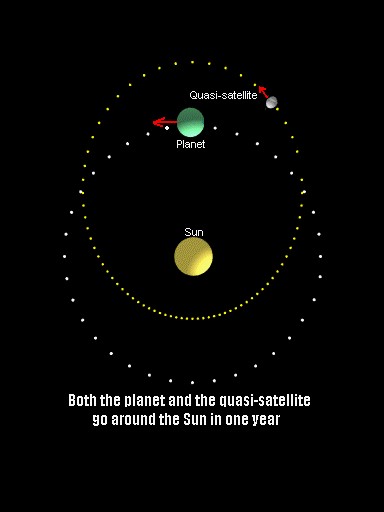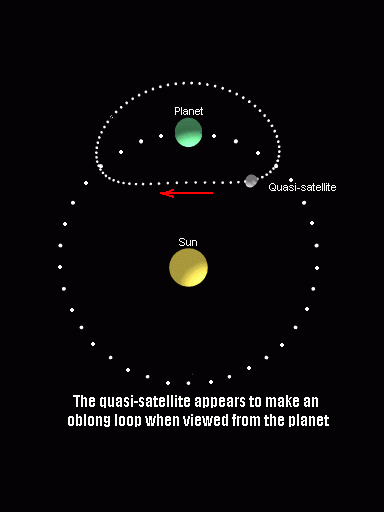

Paul Wiegert and Kimmo Innanen
Dept. of Physics and Astronomy, York University, North York, Ontario, M3J 1P3 CANADA
Seppo Mikkola
Tuorla Observatory, University of Turku, 21500 Piikkio FINLAND
Quasi-satellites, a class of object superficially similar to traditional moons, may exist in the outer reaches of our Solar System. Paul Wiegert, Kim Innanen (York University, Toronto, Canada) and Seppo Mikkola (Tuorla Observatory, Piikkio Finland) have investigated the stability of quasi-satellite orbits around the giant planets Jupiter, Saturn, Uranus and Neptune. They find that quasi-satellites of Uranus and Neptune can survive for the 4.5 billion year age of the Solar System. As a result, they conclude there may remain some fraction of a primordial population of such objects to this day.
A 1:1 mean-motion resonance occurs when two bodies, usually a planet and an asteroid, orbit the Sun in equal amounts of time. The best known cases of this resonance are the Trojan asteroids of Jupiter. Over 400 hundred asteroids remain stable either 60 degrees ahead of or behind Jupiter as it goes around its orbit; both planet and asteroids take 11.86 years to circle the Sun. Quasi-satellites are also bodies in 1:1 mean motion resonance, but one in which they remain in the vicinity of their accompanying planet. This research indicates that populations of such objects may remain in the outer Solar System.
Though quasi-satellites remain close to their planet compared with other 1:1 resonant orbits like Trojans, they should not be confused with traditional satellite orbits. ``A traditional moon or satellite orbits a planet,'' said Dr. Wiegert. ``Quasi-satellites are properly said to orbit the Sun, and though their path takes them around a planet, their behavior is very different from that of ordinary moons''. The distinction between satellites and quasi-satellites arises because quasi-satellites are too far from their planet for it's gravity to exert a significant hold on them, though the planets do play a role in the stability of quasi-satellites.
Over the course of a planet's year, a quasi-satellite will travel once around the Sun. At the same time, the quasi-satellite travels on an oblong loop encompassing its planet (please see the figures below). The difference is one of vantage points: since the planet and quasi-satellite orbit the Sun in the same amount of time, they remain close to each other throughout their journey. An analogy would be two cars (the planet and quasi-satellite) traveling with equal speeds around a circular race track (their orbit around the Sun). Both cars will remain near each other because of their similar velocities without there being any physical connection (eg. strong gravity) between them.
Thus, though a quasi-satellite's ``orbit'' is superficially similar in appearance to a traditional satellite orbit, they are fundamentally different. Despite their differences, however, the similarities may allow quasi-satellite orbits to prove useful for the placement of artificial satellites in near-Earth space in the future.
Quasi-satellites can persist for the age of the Solar System around the planets Uranus and Neptune, but become unstable on much shorter time scales for both Jupiter (10 million yr) and Saturn (less than 100 000 yr). They are most stable when on low inclination orbits and over a restricted range of eccentricities (0.1 to 0.15 for Uranus and Neptune).
Because of this stability, Wiegert, Innanen and Mikkola predict that Uranus and Neptune may well have populations of such objects, though only fairly weak constraints can be placed on their numbers. Jupiter and Saturn are less likely to harbor primordial quasi-satellites; however, the possibility remains that they have transient captured populations of quasi-satellites.


 One
One
 Two
Two
 Three
Three
 Four
Four
 Five
Five
The non-rotating and the rotating frame
The relative motions of a quasi-satellite and its planet are
shown. After two orbits, the lines of sight connecting the QS to the
planet are drawn in green. Both the quasi-satellite and the planet
orbit the Sun in the same amount of time, though the quasi-satellite,
because its orbit is elliptical, moves faster when closer to the Sun
and slower when farther away. Note that, though they both go around
the Sun, both are always on the same side of the Sun and in relatively
close proximity to each other. Then, the planet will begin "picking
up" the lines of sight, constructing the apparent path of the QS as
seen from the orbiting planet. Their motions are such that the QS
appears to perform a kidney-shaped loop around the planet. Though the
QS thus appears to orbit the planet, this is a result of the frame of
reference we are using.
A swarm of quasi-satellites
A hypothetical single or swarm of quasi-satellites is shown orbiting
Neptune. As in the earlier movie, the size of the Sun, planet and
QS's have been exaggerated in order to make them easily visible.
Note that this page is not actively maintained: some information may be out of date.
MPEG movies
Related links
Have a question or comment? Contact me (Paul Wiegert at pwiegert[remove this and put the @ symbol here]uwo.ca)
Quasi-satellite information page
© Copyright 2000-2006 by Paul Wiegert